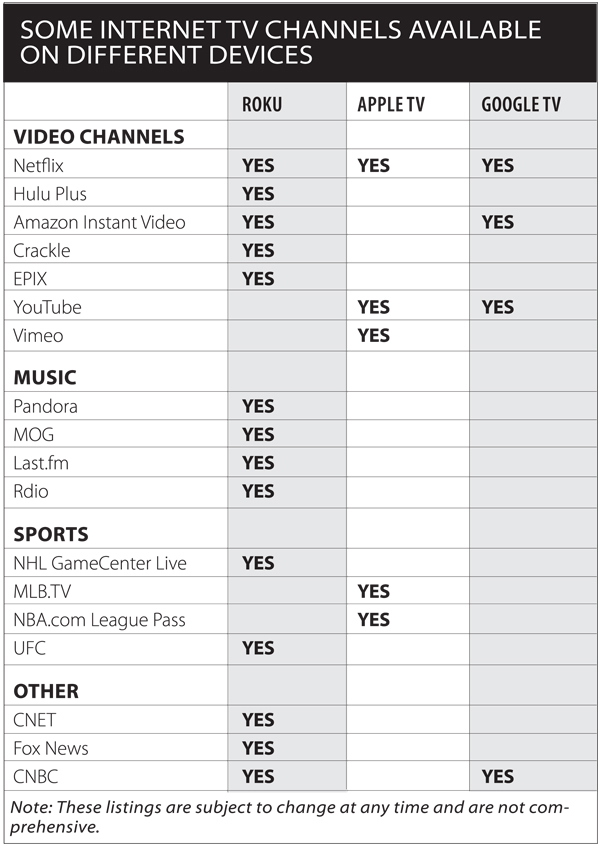COSTLY CABLE
This is no longer a suggestion from left field. According to Web analysts GigaOm, in the second quarter of this year, the major pay TV companies lost a combined total of almost 200,000 subscribers, and it’s a safe bet that many of those were people who simply decided that cable is just too expensive. Part of what’s driving the exodus is that cable TV providers are extracting more and more revenue per user with extra costs attached to digital video recorders, HD and premium channels, and the like. Their success with this tactic is illustrated by the fact that while basic cable can be found for about $39 a month, Comcast generates an average of $140 per month from their subscribers.
THE COMPETITION
It’s no wonder that Internet TV is gaining momentum. But what is there that is really available to watch on devices like the Apple TV, the Roku box and Google TV? It’s hard to give a simple answer. Partly that’s because the device manufacturers themselves are often not as transparent about it as they might be – cynics might suppose that they have a vested interest in hiding just how thin their content offerings really are – but also it’s because the situation is changing constantly.
Recently we have seen Netflix change their pricing model dramatically so that the price of their basic one-disk-plus-streaming package has effectively risen by 60 percent. We have seen Google lean on Roku to stop provision of a private channel that streamed YouTube content to Roku players. And we have seen Apple update their Apple TV software so now you don’t actually need to download a movie when you purchase it. Instead you can now simply stream it on-demand to your TV, your iPhone or your iPad.
All of these changes are the result of big, powerful companies jockeying for position as the market changes. The move from cable TV to the Internet will take some time, but these companies know that it is going to happen eventually, and they want to be well positioned as the competition heats up. What that means for us is we can be sure that over time, more and more content will be available online, but the precise details of what is available and when will change from month to month as these companies battle with each other.
CONSIDERATIONS
So what to do? Here’s the approach and the key issues to think about before pulling the trigger:
1. Do some research. Take a look at the iTunes Store: it has separate tabs for movies and TV shows. Sign up for a free one-week trial of Hulu Plus. Look at Netflix and Amazon Instant Video. Among them, these four services have almost everything that is available online. Think about what you like to watch, and then see if enough of it is available – you may be surprised at just how much there is.
2. The biggest issue with moving to Internet TV is sports. If you’re a sports fan, stick with cable. Internet TV devices offer some coverage – you can find MLB.TV and NBA.com League Pass on Apple TV, for example, but it’s not anywhere near what you can get on cable. Sports channel subscriptions drive a lot of TV-related purchasing decisions, and it’s likely that sports will be the last holdout in the switch from cable to online.
3. If you only watch movies, then making the switch should be pretty painless. All the devices have multiple options for on-demand streaming of movies, and the choices available are excellent.
4. If you are locked into watching series on the main broadcast channels, HBO or Showtime, then you have a decision to make. If half the fun you get is from discussing the latest episode with your friends the day after it airs, you should stick with cable. But if you can wait a few months, most popular series will become available via one or more of the Internet TV channels. How well do you cope with delayed gratification?
Internet TV is coming, and the devices on which to access it aren’t super expensive. If you can afford to spend $100 or so, then you can just jump in and see if you like it. For the more cautious among us, spend an hour or two on research. You may just find that cutting the cable is an easy choice after all.

Chris Trayhorn is the founder of Revenue Performance magazine and the CEO of mThink.com. He knows a lot about online marketing and technology and a little bit about nearly everything else.








